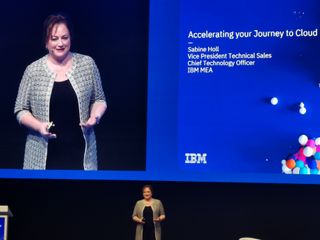IBM sees open-source solutions unlocking world’s potential and driving innovation
Hybrid and multi-cloud platforms are a reality going forward

As digital transformation and the cloud are gaining traction in the Middle East, demand for open-source solutions are intensifying, IBM executives said.
“Open source is key and the future to drive innovation due to the skills challenge posed by the emerging technologies. There are multiple people with different backgrounds coming in together to drive innovation in an open-source community,” Sabine Holl, vice-president for technical sales and CTO, IBM Middle East and Africa, told TechRadar Middle East on the sidelines of the IBM Think Summit.
Holl had installed the first Linux on mainframe 20 years ago.
She said that IBM wants to take the open-source into an enterprise-scale version and that is why IBM and Red Hat came together.
IBM acquired Red Hat for $34b and the biggest acquisition in the IT industry so far.
“Our hybrid multi-cloud environment is open by design. We are basing our architectural design on open architecture and open standards. We have embarked on this journey 20 years ago.
“We have built a culture at IBM for open source. We have spent more than $1b on supporting open-source platforms, partnering with spenders and clients equally to turn this great idea which comes out of open source community,” she said.
Are you a pro? Subscribe to our newsletter
Sign up to the TechRadar Pro newsletter to get all the top news, opinion, features and guidance your business needs to succeed!
Linux is powering more than 50% of the server market in the world and.
Moreover, she said that open standards liberate apps, workloads and developers while it is secure and open access to data and AI for new insights.
Adrian Pickering, regional general manager for Red Hat Middle East and North Africa, said that governments in the Middle East are supporting open source as a platform for innovation and to tackle digital disruption and delivery services. I
“It is gaining much-needed traction as organisations try to find the right mix between innovation and cost efficiencies,” he said.
Retain flexibility and reduce vendor lock-in
Red Hat is the number one open-source solutions provider with Red Hat OpenShift and Red Hat Enterprise Linux and IBM’s middleware is also based on open source technology.
There are many open-source projects out there, Holl said but that might have been developed by one or two people.
“If the developers leave, your project will not be maintained and get further developed. Because of these issues, we, partners and ISPs all work together to provide the open platform such as Dockers, Kubernetes and Linux,” she said.
Multi-cloud is a fact such as on-premises, private and public cloud across multiple vendors, she said and added that it has to be an open-source technology to retain flexibility, reduce vendor lock-in and secure.
“With the Red Hat acquisition, we have been working together for many years and knew each for a long time. Red Hat is the number one open-source solutions provider in the world and together, we are the number one hybrid cloud provider in the world,” she said.
Over the next three years, she said that enterprises will modernise 75% of existing apps to move to the cloud as modernising is important because enterprises have invested a lot in the past years to serve the clients.
Build once and deploy anywhere is the new mantra
However, Holl said that enterprises will leverage what they have done and infuse new technologies but they also need to develop new applications.
“Enterprises are moving mission-critical apps to the cloud. In the last ten years, we were looking at cloud and cognitive era and enterprises have started to explore bringing out mobile apps and social media in a bid to change the customer experience. This was only 20% of the workload we saw,” she said.
So, what is preventing the remaining 80% from moving to the cloud, she asked.
The reasons, she said are unique workloads and data needs (compliance, security, location require choice), multiple clouds and vendors (hard to connect across clouds and the data centre), and technology generation gap (need to broker cloud-native and traditional).
“In the future, it will be build once and deploy anywhere (for optimised data and workload placement), open and integrated approach (visibility, governance and secure data access),” she said.
